Are you thinking about tackling a DIY crawl space encapsulation project? Before jumping in and starting the process, consider if it’s a good idea. We say that because DIY crawl space encapsulation can potentially do more harm than good, creating serious safety issues for homeowners.
This blog post will discuss why trying your luck with DIY crawl space encapsulation may not be such a great idea. Knowing what’s at stake will make it easier for you to make an informed decision.
What Is Crawl Space Encapsulation?
Crawl space encapsulation involves sealing the vents and covering the floor and walls of your home’s crawl space with a thick, plastic vapor barrier. This reduces moisture in the crawl space, increases energy efficiency, and improves indoor air quality in your home’s living area. Once the vapor barrier is installed, most homeowners also install a dehumidifier in the crawl space to ensure the humidity level remains low.
What Are The Benefits Of Crawl Space Encapsulation?
Crawl space encapsulation has several benefits, making it essential for any home with a crawl space foundation. These include:
- Encapsulating a crawl space prevents moisture buildup that can cause structural damage over time.
- Crawl space encapsulation increases energy efficiency by reducing air leakage and drafts. Also, drier air is less expensive to heat and cool.
- Encapsulating your home’s crawl space also helps improve indoor air quality by preventing mold and dust mites that may accumulate in the crawl space. (A percentage of air from the crawl space enters your home’s living area via a phenomenon called the “stack effect.”)
- Adding insulation will act as a buffer between the outside environment and your living area, allowing you to maintain a consistent temperature without worrying about air escaping.
Why DIY Crawl Space Encapsulation Is A Bad Idea
While DIY approaches to some home improvement projects can be cost-effective, crawl space encapsulation is not one of them. There are several reasons why homeowners should avoid attempting to encapsulate their crawl space themselves. These include the following:
- Crawling around underneath your home isn’t easy and can even be dangerous. Never enter your crawl space without wearing protective gear, including a respirator.
- Before you begin, you’d need to clean the area. This isn’t easy when working in a space that’s only 1.5-3 feet high. In fact, we don’t recommend that any homeowner enter their crawl space. It’s just too dangerous.
- Crawl space encapsulation isn’t a job for one person. When we encapsulate a crawl space, we use an experienced crew of 2-3, and it takes us from 1-3 days.
- DIY crawl space encapsulation doesn’t come with a warranty.
- When you encapsulate the crawl space yourself, you miss out on having a foundation repair professional take a look inside your crawl space. If you have a problem, they’ll be able to spot it.
Ultimately, the benefits of hiring a professional to encapsulate your home’s crawl space far outweigh the risks associated with a DIY approach.
The Crawl Space Encapsulation Process
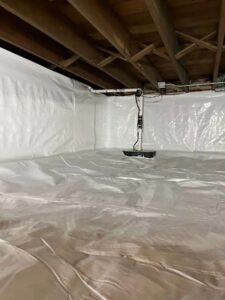
The general crawl space encapsulation process is as follows:
- The crawl space is cleaned, and any debris is removed.
- The vapor barrier is placed over the crawl space floor and walls.
- The seams are taped so the dirt floor is effectively sealed off from the rest of the crawl space.
- Many homeowners also choose to install a dehumidifier to ensure the humidity level in the crawl space remains low.
Crawl space encapsulation usually takes 1-3 days, depending on the size of the crawl space.
Kick It Up A Notch With Encapsulation Plus A Drain Tile System
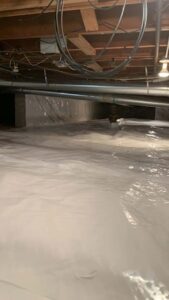
The ultimate crawl space waterproofing solution is encapsulation along with a drain tile system. A drain tile system is the ultimate foundation waterproofing system because it doesn’t just put up a barrier to keep moisture out. It actually prevents moisture from building up in the soil in the first place.
There are two types of drain tile systems: exterior and interior. An exterior drain tile system goes around the outside perimeter of the foundation at the footing level. The general installation procedure is as follows:
- The soil around the foundation is excavated down to the footing.
- A shallow trench is dug and then lined with gravel.
- A perforated drainage pipe is placed into the trench and covered with more gravel.
- The excavated soil is replaced.
Any excess moisture in the soil will find its way into the perforated drainage pipe and get channeled toward a sump pit. Once the pit fills with water, a sump pump will turn on and expel it away from the foundation.
An interior drain tile system is installed around the inside perimeter of a basement or crawl space. In the case of a basement, this means tearing up the floor using a jackhammer in order to dig the trench.
Installing a drain tile system is not a DIY project.
For more information see, Crawl Space Encapsulation Cost Explained.
Tips On How To Find A Professional Instead Of Doing DIY Crawl Space Encapsulation
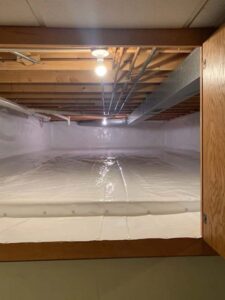
Because you don’t want to hire just anyone to encapsulate your home’s crawl space, you need to do some homework:
- Read online reviews to find out what other homeowners say about the contractor.
- Look for contractors with plenty of experience encapsulating crawl spaces.
Shop around and get quotes from at least three different contractors. - Don’t automatically go with the lowest price.
- Speak with each contractor and ask about their timeline for getting the job done, warranty, and references from previous customers.
Following these tips, you can find a reliable and professional contractor to encapsulate your crawl space and improve your home’s comfort and value.
While it may be tempting, DIY crawl space encapsulation is not the best way to protect your home’s crawl space from moisture damage. Encapsulation is a messy job that can even be dangerous. If you want to encapsulate your home’s crawl space, your best bet is to hire a professional. They know how to get the job done quickly and correctly. You’ll also get a warranty with it!
If you’re in Chicagoland and interested in crawl space encapsulation, contact The Real Seal today to schedule a crawl space evaluation and receive an encapsulation estimate.
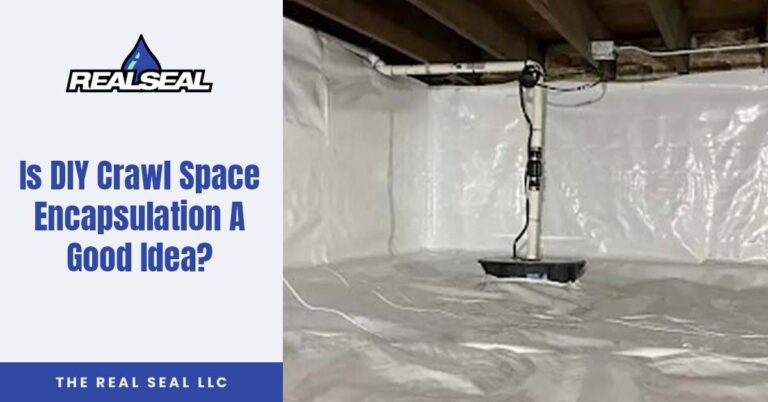
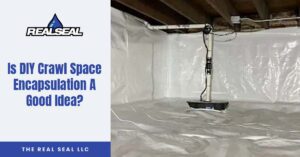





8 Responses
Great post! I’ve been considering DIY crawl space encapsulation for a while now, and your insights on the potential benefits and pitfalls are super helpful. It’s definitely a big project, but I think the cost savings make it worth a try. Thanks for sharing your thoughts!
Thanks so much!
I found this post incredibly helpful! The breakdown of the pros and cons of DIY crawl space encapsulation really clarified my decision-making process. I appreciate the tips and resources you’ve provided. It’s definitely something I’m considering now!
Happy to help!
Great post! I’ve been considering DIY crawl space encapsulation, and your insights on the benefits and challenges really helped clarify my decision. It’s good to know about the potential moisture issues and insulation impacts. Thanks for sharing your expertise!
Happy to help!
I found this post really informative! I’ve been considering DIY crawl space encapsulation for a while, and your insights on the benefits and potential challenges are super helpful. It’s good to know what to look out for before starting this project. Thanks for sharing your experiences!
Always happy to share!